So, I dropped by HF after work today, and after spending my usual 45 minutes browsing all the amazing stuff which I positively do not need, yet can't seem to resist, I made my way to the "lock" section (notice the other clones, all of which were also removable core, and some of the locks are as little as $1.99!)
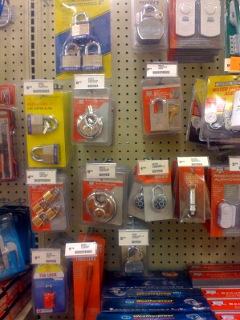
Sure enough, for $9.99, I picked up this beauty:
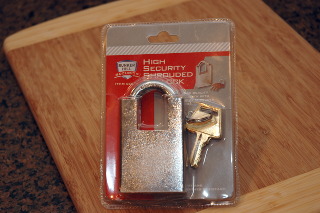
The finish isn't nice, but it sure looked like an American 5300, right down to the bow on the keys. (Then again it had been a long day, and my brain was weakened by long-term exposure to cheap Chinese imports...)
Let the Comparison Begin!
First things first, I picked the lock. First attempt: 6 seconds. Things are not looking good. I didn't feel any spools or serrations, but it all happened so quickly.
Here is an American 1105, a Brinks Shrouded, and the Bunker Hill Security "High Security Shrouded Padlock" all together:
Front View
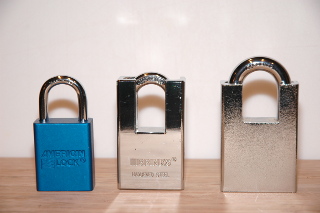
Okay, looking good. The Bunker Hill model is bigger, and therefore better, right?
Bottom View (core removed)
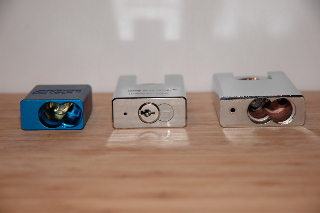
The 1105 is aluminum, nice and pretty. The Brinks isn't a removable core. (Also, it has 6 pins, instead of the usual American 6-chamber plug pinned for 5...) And the Bunker Hill... well, it's a bit rusty and scary inside.
Closeup of Bunker Hill Internals
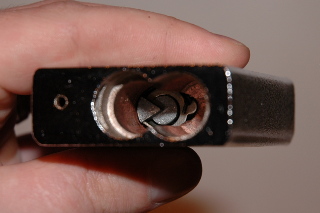
American locks use a quarter circle for the shackle cam, which has some weaknesses. (Which can't be discussed here) The Bunker Hill not only has a nice case of rust going, but also has replaced the quarter circle cam with a 1/6th circle.
Core Comparisons (American 1105 left, Bunker Hill right)
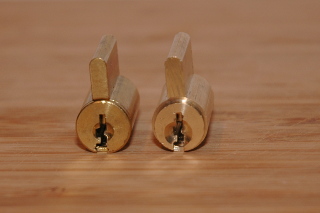
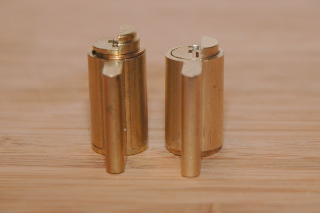
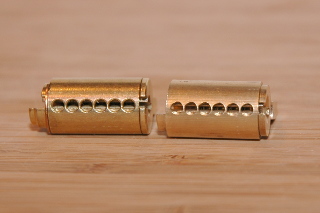
At first glance, the cores look nearly identical, but as you look closer, more and more differences appear. In the first picture, the cores are seen from the face. The only obvious difference is a slight difference in side of the plug faces. (One thing to note is that the lock on the left has been pick probably 50 times, and the one on the right less than 5. Notice the wear is about equal! The brass on the Bunker Hill lock is very soft!)
The second picture shows the cam end of the plug. Here differences start to be seen. Both locks use a half-circle; however, the American plug is slightly longer, and uses a thin brass circlip to retain the plug in the shell. Interestingly, the Bunker hill has nothing at the back of the plug holding the plug into the shell.
In the third picture, the shells look very similar, with the only notable difference being the American appears to either be drilled or formed, and the Bunker Hill appears to be punched or stamped.
Plug Rotations (American 1105 left, Bunker Hill right)
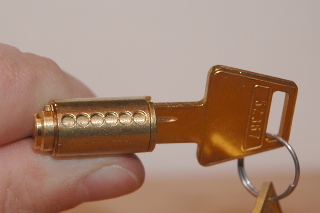
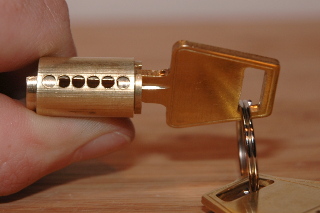
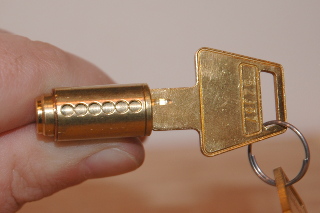
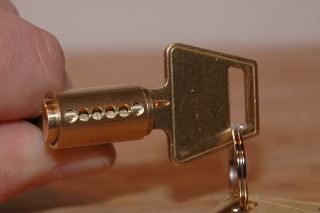
Now things get interesting! The holes in the bottom of the shell are normally used to allow recombination (rekeying) of the lock without the need to remove the plug from the shell using a follower. In the first row of pictures, the correct key is inserted into the cores and turned about 30 degrees clockwise. On the American 1105 core (left) the view through the holes is of the solid plug, as expected. On the Bunker Hill lock though, something unusual is going on. A huge gap is exposed where the plug has been milled away, the first and sixth holes are blocked, but the rest are clear.
The second row of pictures show the plug rotated 80 degrees. On the American 1105, the plug still shows as solid metal, and on the Bunker Hill, the milled away section is clearly visible. At this point, the Bunker Hill lock will not turn any further. The total rotation of the Bunker Hill lock is about 80 degrees. The American can be rotated a full 360 degrees.
Semi-Conclusions
1. The Bunker Hill lock is probably over-priced at $9.99. Between the poor construction quality and ease of picking, the only possible virtue it has is possible increased resistance to DE (assuming the metal isn't junk, which is always a possiblity)
2. The core is removable, but not rekeyable. I'm not sure what the point of having a removable, non-rekeyable core is in a lock this cheap. It seems to introduce more weakness than a sealed design like the Brinks.
3. There do not appear to be any security pins, but I haven't been able to verify this directly.
4. I believe the plug is held into the shell via a pin in the sixth chamber, which doesn't interact with the shearline because the plug is cut away. I don't know why as much of the plug is cut away as is though...
Next Steps
I'm reluctant to cut into the bible of this lock, simply because I don't like breaking things. However, unless someone has another method, I think it's the only way to see what is inside.



